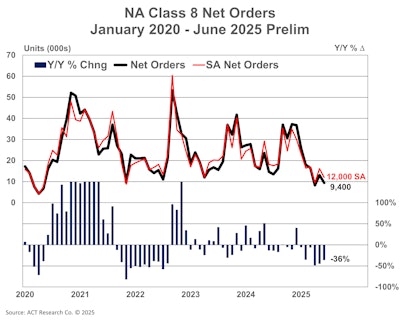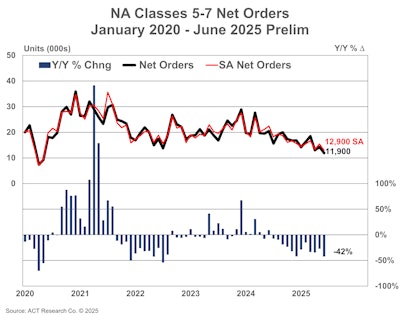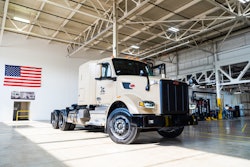North American Class 8 truck orders continued their downward trend in June, FTR and ACT Research announced Wednesday.
FTR pegged the month at 8,900 units; ACT was slightly higher at 9,400 units in the Class 8 space and 21,300 units across Classes 5-8.
FTR says its preliminary total was the lowest number for June since 2009, down 25% from last month, 36% year over year and less than half of the 10-year monthly average for June of 19,213 units. ACT says its Class 8 estimate was down 36% year over year.

Historically, FTR states June often experiences a modest month-over-month increase. The company posits this year’s shift the other direction could be due to ongoing tariff volatility coupled with economic and freight market uncertainty.
In evaluating the data, the company notes both on-highway and vocational segments experienced reduced demand in June. For the 2025 order season so far (September 2024 through June 2025), net orders are down 15%, FTR states, and in 2025 orders are down 32% year to date. Class 8 orders for the past 12 months are 255,265 units.
“Market uncertainty is further heightened by the potential implementation of Section 232 tariffs on Class 8 trucks and their components along with anticipated revisions to EPA 2027 NOx emissions standards,” says Dan Moyer, FTR senior analyst, commercial vehicles. “As a result, many fleets are postponing equipment purchases. Record-high inventories are placing additional downward pressure on demand and production.”
“Publicly traded for-hire fleets ended 2025 Q1 with the weakest net income margins since the first quarter of 2010,” adds Carter Vieth, research analyst at ACT. “Private fleets have spent the past two years adding fleet capacity and have little need for additional supply. On the vocational side, worsening housing and construction markets and regulation uncertainty has sapped strength that looked all but certain at the beginning of the year.”
And FTR adds tariff volatility and economic and freight uncertainty remain a challenge. Recent tariff hikes — most notably the increase from 25% to 50% on steel, aluminum and fabricated components that took effect June 4 — have significantly raised production costs as demand has deteriorated. Other tariffs remain in flux, and trade deals with many top U.S. trade partners have yet to be finalized.

As for the medium-duty space, Vieth notes economic uncertainty and higher prices continued to weigh on demand in June. Preliminary Classes 5-7 orders were 11,900, which Vieth states is “the weakest net order tally since the pandemic, surpassing April's ‘Liberation Day’ impacted orders, for the ‘lowest-since’ designation.”











